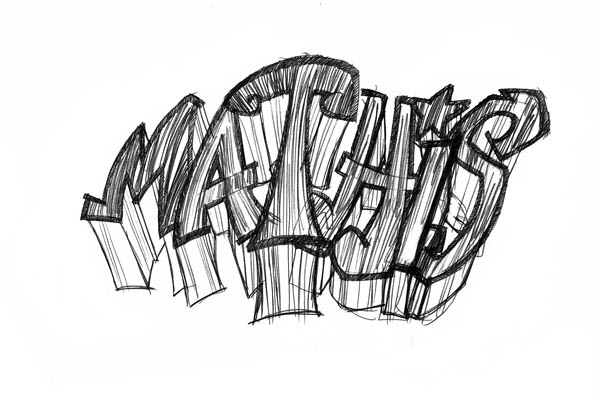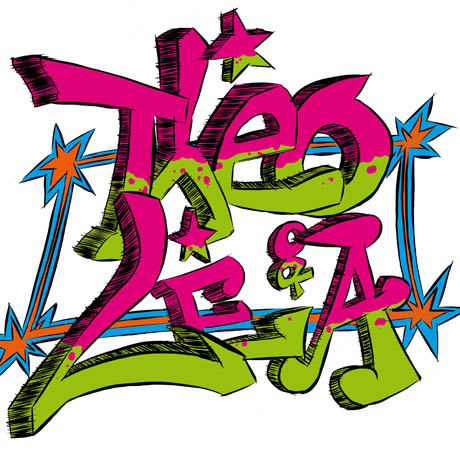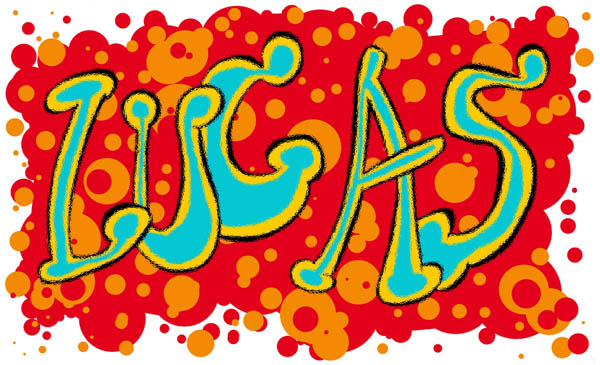Do you dream of covering your room's walls with graffiti? Here are a few examples of sketch (graffiti on a sheet of paper) for practicing. No need to get bogged down under heaps of material: a large sheet of Canson paper (French format "raisin"), pencil, large marker and some watercolours or felt pens will do the trick!
- Home
- Expert advice
- Activities for kids: Graffiti

1. Distort the letters
- Practice distorting the letters of your graffiti as much as possible: stretch, knead, twist and finally highlight your letters (try this with a pencil on an ordinary sheet of paper, experimenting with all of the different shapes until you find your style).
- You needn't be bothered too much by how they look, for right now they are nothing short of punchy: the lines may (and must!) spill over.
- Replace the accents with stars or any other symbol.

2. Add emphasis
- Use a marker to highlight the edges of the letters in such a way as to bring them out fully.
- Use a marker with a finer tip to highlight the letters: trace dynamic hatches all around the letters (but not on top of them).
The letters of your graffiti should almost seem alive!

3. Colour your graffiti
The colours must dazzle: make them fun by reaching for the flashiest colours at the bottom of your drawer!

4. Highlight your graffiti
It is important that you put your graffiti in a "backdrop" of colour which will make it all the more striking. Do not use the same colours as the ones you used for the letters.


5. A few ideas
Here are the more "sober" models, which are still quite impressive.
1) The effect of the graffiti is strong enough all by itself that we can get away with a rather simple background and dynamic (there's that word again!) yet subtle framework.
2) A less aggressive style. To make the background, simply cut out a cover in the shape of your graffiti and splatter on some drops of paint (you will need thicker paper for this).
Recommended product:
Graduate Bristol
Explore more tutorials on this technique
For kids
Making an Easter bunny
For kids
Make a present for Mother's Day
For kids
Create a paper pencil pot
For kids
Create masks
For kids
Make a Valentine's Day Gift
For kids
Create corrugated cardboard totems
For kids
Make expressive faces out of paper
For kids
Make a corrugated cardboard parrot
For kids
Create a paper mandala
For kids
Making a paper hot-air balloon
For kids
Make a 3D paper landscape
For kids
Make 3D toys out of paper
For kids
Make a paper mâché globe
For kids
Create a garland for April Fools Day
For kids
Make a silhouette card
For kids
Making corrugated cardboard arrows
For kids
Make a chronological frieze
For kids
Make a paper cactus
For kids
Drawing a Horse
For kids
Making a secret egg box from card
For kids
Drawing a boat
For kids
Create a four seasons picture
For kids
Create a botanical book
For kids
Create a star mosaic
For kids
Create a beautiful glittering star
For kids
Making a snowflake
For kids
Create a shape memory game
For kids
Drawing a Knight on Horseback
For kids
Drawing a Happy Dolphin
For kids
Drawing a Playful Dolphin
For kids
Drawing a Griffin
For kids
Drawing children
For kids
Drawing a Penguin
For kids
Drawing a Horse and Cart
For kids
Draw a soldier
For kids
Drawing a Foal
For kids
Drawing a turtle
For kids
How to make ladybirds
For kids
Drawing a castle
For kids
Set off to discover modern history
For kids
Create a pop-up card
For kids
Activities for kids: Drawing a horse
For kids
Activities for kids: Drawing a cat
For kids
Activities for kids: Drawing a hand
For kids
Your children's graphic development
For kids
Playing with one's children
For kids
Drawing a Dragon
